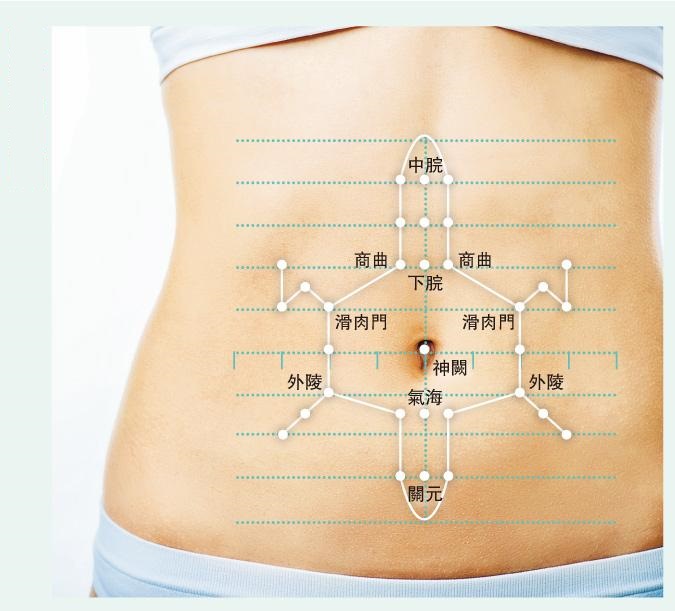Chinese medicine treatment, belly painting turtle, neck pain

[Exclusive report from Ming Pao] The Chinese University of Hong Kong and Pok Oi Hospital recently collaborated on a study to use “abdominal acupuncture” to treat neck pain, with significant results. Abdominal acupuncture is centered on the navel and connects nearby acupuncture points to form a turtle-shaped pattern, called the Divine Turtle Diagram, to treat pain in the neck, shoulders, hands, and feet.
Since abdominal acupuncture does not need to touch the painful area, it is suitable for patients who are afraid of pain. Urbanites are all phone-dwellers, and everyone suffers from neck and shoulder pain. How can abdominal acupuncture relieve the pain? In addition to neck pain, can abdominal acupuncture treat other diseases?
Many city dwellers also suffer from neck pain, and this reporter is no exception. He has been suffering from pain in his right shoulder and neck for nearly three months, with muscles tense. This time he personally tested the effect of abdominal acupuncture. After diagnosis by registered Chinese medicine practitioner Shi Minqi, the goal was to use abdominal acupuncture to relieve the pain in the right shoulder and neck. When the first needle was inserted into the upper abdomen, obvious pain was felt. Shi Minqi explained that the reporter was thin and had little abdominal fat, so the feeling of the needle entering was stronger. After that, the needle was inserted into the lower abdomen where there was more fat, and the soreness was significantly lighter and almost painless.
Reporter’s test: The pain is lighter than acupuncture
The reporter feels that the pain of abdominal acupuncture is significantly lighter than that of traditional acupuncture. The needles were left in for about 20 minutes, during which time the Chinese doctor asked the reporter to turn his neck. He felt that his muscles were noticeably relaxed and the pain was greatly reduced. Shi Minqi added that not all patients will see immediate effects after abdominal acupuncture. Elderly or weak patients may take longer to feel the effects.
The pain of abdominal acupuncture is lighter than that of traditional acupuncture. Shi Minqi explained that this is because there are no large nerves and blood vessels near the acupuncture points on the abdomen, so the response to pain is relatively slow. In addition, traditional acupuncture uses needles to stimulate acupuncture points, producing feelings of soreness, numbness, swelling and pain, thereby achieving a therapeutic effect; however, the principle of abdominal acupuncture is different from traditional acupuncture, and it also has a therapeutic effect, but there are no such feelings of soreness, numbness, swelling and pain, which greatly reduces the pain. Another benefit of abdominal acupuncture is that the treatment site is far away from the affected area, and the movement of the affected area will not be affected after acupuncture. After receiving the abdominal acupuncture, the reporter felt no swelling or soreness in his shoulders and neck and could move around as usual; however, he felt soreness in his abdomen throughout the day and it disappeared the next day. Shi suggested that the abdomen should not be wet within 2 hours after abdominal acupuncture.
Abdominal acupuncture can be helpful for shoulder and neck pain and can provide patients with another treatment option. Shi Minqi explained that some patients are afraid of pain and resist acupuncture on the affected area. Abdominal acupuncture does not require the needle to be placed on the affected area, which can reduce the patient’s tension and resistance, making it easier for the patient to accept. “A 37-year-old man suddenly felt significant pain in his waist after holding a child. He had a slipped waist (acute lumbar muscle sprain), which affected his bending range and extended the pain to his lower limbs. The patient’s waist pain was very severe. He was nervous during the examination and was in so much pain that he could not lie on the treatment bed. He was unwilling to have acupuncture in the affected area. We switched to abdominal acupuncture for treatment. The patient was more receptive and willing to continue the treatment.”
In some parts of the body, such as finger joints, the pain of needle insertion is more intense, and acupuncture may also affect the ability to move. Although abdominal acupuncture causes a feeling of soreness and pain in the abdomen, it will not affect the movement of the affected area. In addition, the amplitude of abdominal movement is relatively small, so the soreness and pain will disappear quickly. A 43-year-old accountant suffered from shoulder and neck pain due to frequent computer use, and also suffered from “trigger finger” (injury to the metacarpophalangeal joint of the thumb). The joint connecting the metacarpal bone of the thumb and the thumb bone was painful. Although there were acupuncture points nearby for acupuncture treatment, it was usually very painful and the joint could not be flexed or extended after the needle was inserted. Finally, abdominal acupuncture was used for treatment. After the needle was inserted, the abdominal needle was gently twisted. After 1 to 2 minutes, the patient felt that the shoulder and neck muscles were relaxed, and the pain was relieved when the thumb was straightened.
Pregnant women, patients with abdominal tumors, hepatosplenomegaly should not use
Basically, most people can accept abdominal acupuncture; however, it is not suitable for pregnant women, people with abdominal tumors, hepatosplenomegaly and other organic abdominal diseases. Shi Minqi suggested that for treating general pain, a course of treatment should be 8 to 10 times, with intensive treatment in the initial stage. It is best to have injections every day for the first 3 times, and then injections can be given every other day, depending on the progress of the disease. The therapeutic effect of abdominal acupuncture can last for a period of time. Taking mild neck pain as an example, the cure rate is close to 80%. However, if you do not improve your posture and continue to look down at your phone, or if the pain is caused by structural problems such as cervical degeneration, the pain may recur.
Abdominal acupuncture has many benefits, so can we give up traditional acupuncture? Shi Minqi emphasized that “abdominal acupuncture is another treatment option. In some cases, abdominal acupuncture can be combined with traditional acupuncture.” For example, when treating patients with sprained ankles due to “Ao Chai”, needles can be placed near the affected area at the same time. Abdominal acupuncture and traditional acupuncture each have their own advantages and are used according to different diseases.
■Know more
Middle acupuncture improves the condition, deep acupuncture nourishes the internal organs
Abdominal acupuncture can treat both the neck and the feet and has many effects. What is the principle?
To understand abdominal acupuncture, you must first understand traditional acupuncture. Traditional acupuncture involves inserting needles into acupuncture points to produce sensations of soreness, numbness, swelling and pain. These sensations are called “getting qi”. The qi is then transmitted to the affected area through the meridians, and the “qi reaches the affected area” to improve the condition. Shi Minqi explained that traditional acupuncture is divided into distal acupuncture and local acupuncture. The former stimulates the acupuncture points far away from the affected area to stimulate the affected area through the meridians; local acupuncture places needles near the affected area to improve the condition.
Founded by a mainland acupuncture professor
Abdominal acupuncture was first developed by mainland Chinese medicine and acupuncture professor Bo Zhiyun. Shi Minqi pointed out that “Bo Zhiyun discovered that the navel is a transmitting station that supplies nutrition and qi and blood to the whole body.” From invisible essence to embryo formation, humans absorb nutrients from the mother through the navel and then transport them throughout the body. The abdominal acupuncture theory is centered on the Shenque regulatory system, which is the center of the navel. There are many acupoints near the navel. Connecting the acupoints together forms a turtle-shaped pattern called the Divine Turtle Diagram. The positions of the turtle’s neck, shoulders, hands, and feet correspond to the patient’s neck, shoulders, hands, and feet. In addition to treating pain, abdominal acupuncture can also be used to treat other chronic diseases, gynecological diseases, gastrointestinal and urological diseases, etc.
Abdominal acupuncture can be used to find appropriate acupoints based on the Divine Turtle Diagram. The application of abdominal acupuncture involves three major areas: reflexology, meridian system and organ health care. Each has different functions and the depth of needle insertion is also different. It is divided into shallow, medium and deep acupuncture:
- Shallow puncture: punctures the subcutaneous tissue and has a reflex effect
The acupuncture points shown on the Divine Turtle Diagram correspond to reflex points on different parts of the human body. When treating pain, acupuncture is used for relevant reflex points. For example, for shoulder and neck pain, acupuncture is used for the Shangqu point of Guijing.
- Middle acupuncture: piercing the fat layer, meridian system
According to the traditional acupuncture meridian concept, the acupuncture points on the abdomen are connected to the meridians, and the condition can be improved by stimulating the acupuncture points and systems. For example, Huaroumen and Wailing belong to the stomach meridian. Acupuncture of these two points can help improve stomach and digestive problems.
- Deep needling: piercing into the subcutaneous tissue, mainly to “tonify the internal organs”
Using different acupoint combinations in the Divine Turtle Diagram can nourish the internal organs. The most commonly used combination is “Yin Qi Gui Yuan”, which includes Zhongwan, Xiawan, Qihai and Guanyuan as Ren Meridian acupoints, which can strengthen the body and nourish the vital energy. Because Zhongwan and Xiawan belong to the spleen and stomach, and the spleen governs the muscles; while Qihai and Guanyuan belong to the kidneys, and the kidneys govern the bones. “Acupuncture at these four points can help improve pain. When diagnosing and treating pain, we should first understand the patient’s health condition. If we find that the patient has spleen deficiency, we can improve the spleen and kidneys at the same time.” Shi Minqi added that the abdomen has the abdominal wall layer and subcutaneous fat, so even if the needle is deep, it will not cause too much pain, and there is no need to worry about piercing the internal organs.

